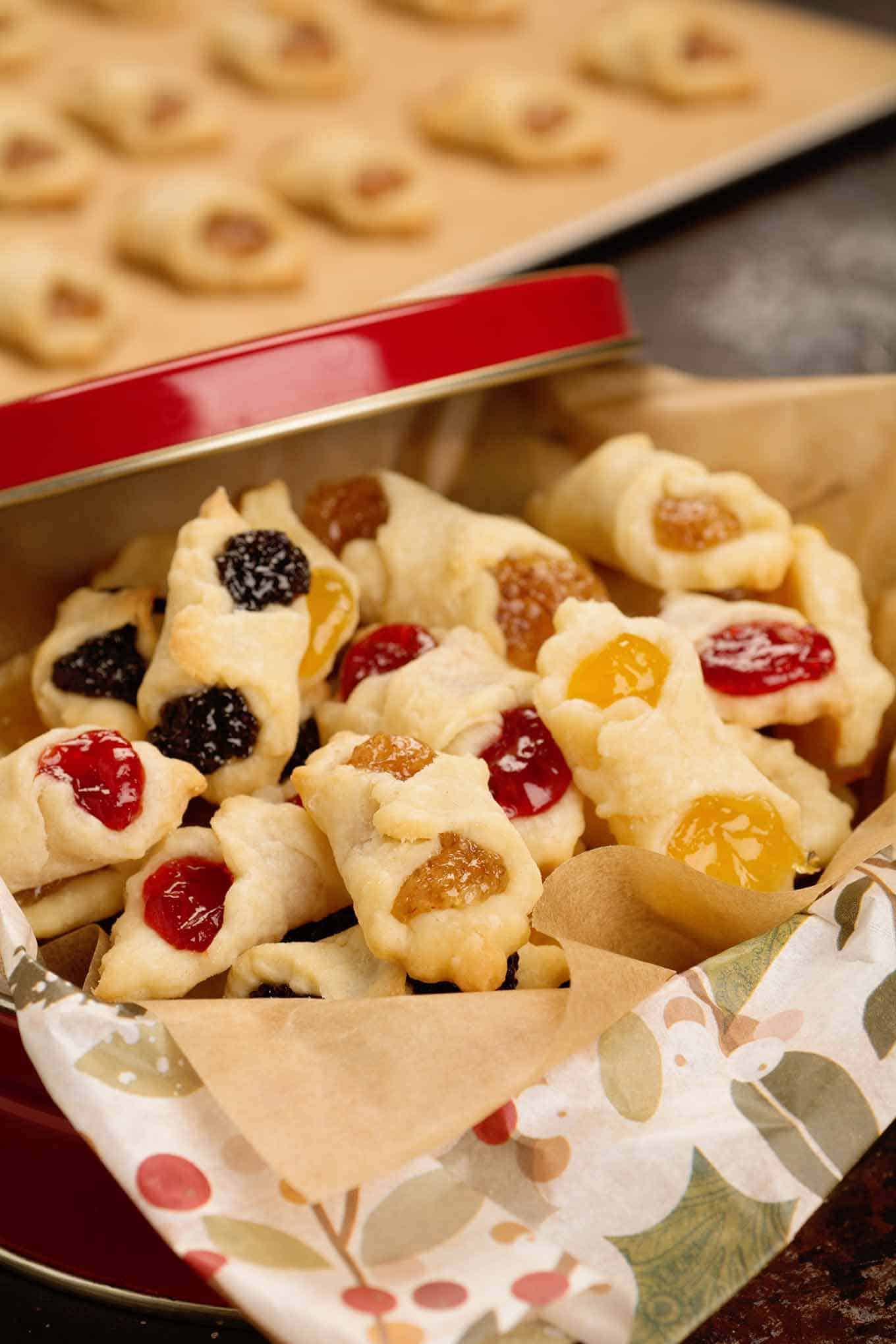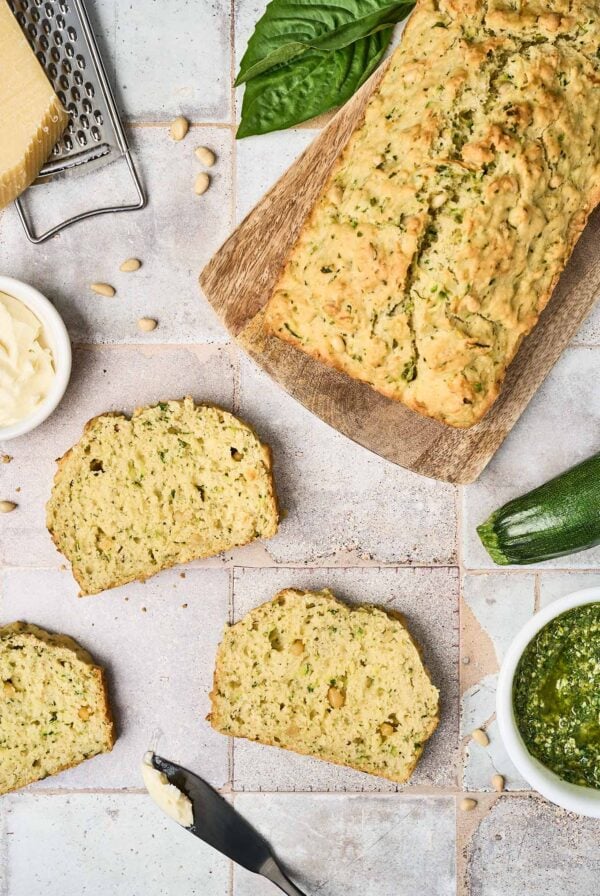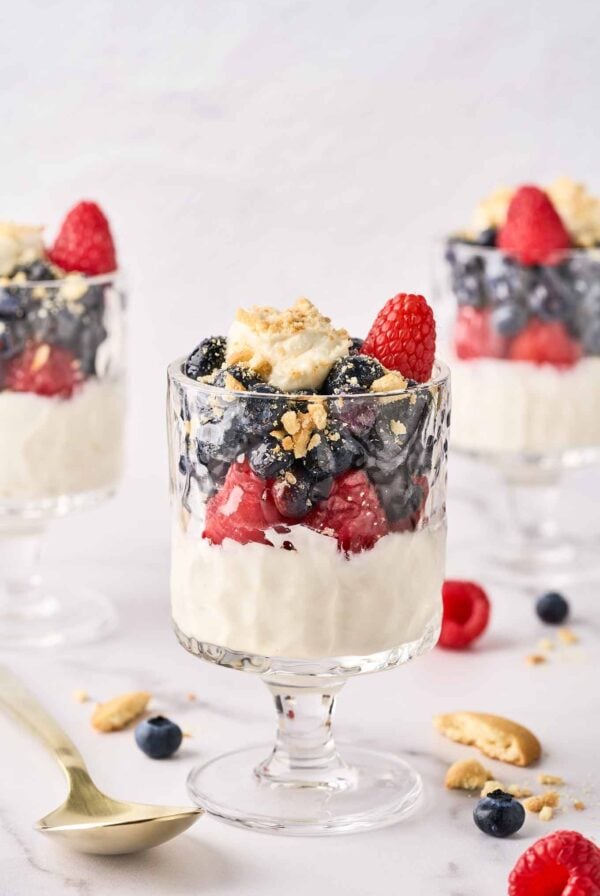This post may contain affiliate links. Please see our disclosure policy.

Preparing these cookies requires a bit of a time investment, but they are such a special treat we know you’ll find them well worth the effort.
Hungarian Kiffles (Kiflis) Are A Holiday Tradition
Being of Hungarian descent, kiffles (also spelled kifli) have always been on hand at our family gatherings during the holidays. They take some work to prepare, but one bite will prove they’re well worth the effort.
Kiffles are delicate Hungarian cookies made with cream cheese dough and filled with various flavors of pastry filling. They make a beautiful contribution to any holiday cookie platter.

About Kiffle (Kifli) Fillings
It is very important that you use fillings that are made specifically for pastry in your kiffles. Pie filling will be too loose and jams and preserves can produce unpredictable results.
We’ve always used Solo Brand Cake & Pastry Filling and have never been disappointed. Solo makes a variety of flavors in 12-ounce cans. Pictured here are poppy seed, cherry, almond, and apricot.
Prune (lekvar in Hungarian), walnut, and poppy seed are the most traditional Hungarian choices and if you read through the comments, you’ll see that a few of our readers have included instructions for making these two fillings from scratch.
Pro Tip: How to Make All Your Kiffles the Same Size
Making sure your kiffles are uniform in size is not only about a beautiful presentation, it’s about even baking. The trick is to roll the dough into a perfect 9-inch square. Here’s how to do it:
- Cut a sheet of parchment paper 15 inches wide by 18 inches long. Fold 4-1/2 inches of each short side toward the middle. Make sharp creases and unfold.
- Fold 3 inches of each long side toward the center. Make sharp creases there as well and you should have a well-defined 9-inch square in the center of your parchment paper.
- With the flaps facing up, dust the parchment liberally with flour and place a portion of dough in the center of the square.
- Dust the top of the dough with flour as well, then fold the parchment along your creases to make an “envelope” around your dough.
- Turn it over (flap sides down) and place it on your rolling surface.
- Roll the dough from the center toward the corners as directed above.
- Remove the dough carefully to avoid tearing.
Once you have the dough rolled into a perfect square, you can easily mark off even intervals of 1-1/2-inches (6 per side) with the tip of a knife. Use your pastry wheel to make the cuts and you will get 36 kiffles (kiflis) per square.


Hungarian Kiffles
Ingredients
- 2-1/4 cups all-purpose flour, plus more for rolling
- 1/2 teaspoon salt
- 8 ounces cream cheese, softened
- 1 cup (1/2 lb) unsalted butter, softened
- 2 to 2-1/2 cups cake and pastry filling, about two 12-ounce cans
Instructions
Prepare the Dough:
- Whisk the flour and salt together in a medium bowl and set aside.
- Beat the cream cheese and butter with an electric mixer on medium speed until very smooth and creamy, 2 to 3 minutes.
- Reduce the mixer speed to low and add the flour mixture, 1/4 cup at a time, mixing just until combined. The dough will be quite moist, but not sticky.
- Turn the dough out onto a lightly floured surface and flatten into a square approximately 1/2-inch thick. Cut into 4 equal pieces and wrap each separately in plastic wrap. Refrigerate until firm, a minimum of 2 hours.
Roll and Cut the Dough:
- Preheat the oven to 375°F and position a rack in the center of the oven. Line a large cookie sheet with parchment paper.
- Remove one portion of the dough from the refrigerator and place it on a liberally floured surface.
- Dust the top of the dough with flour and cover with a sheet of wax or parchment paper. Working from the center toward the corners, roll the dough out to a 1/8-inch-thick square. It should measure about 9 inches.
- For best results, see our recipe notes below to learn how to roll your dough into a perfect square.
- Using a pastry wheel or a sharp knife, cut your dough both lengthwise and crosswise into small squares.
- Your total yield will depend on how large you make them. We recommend 1-1/2-inches which will give you 36 kiffles per square of dough or about 12 dozen total.
- The best way to keep the size even is to use a ruler and mark all 4 sides of the dough square at intervals with the tip of a knife. You can use the handle of a spatula to guide you as you cut to keep your lines straight as well (similar to drawing straight lines on a sheet of paper).
Fill and Seal the Kiffles:
- Working as quickly as possible, place a small mound of filling (about 1/2 to 3/4 teaspoon) in the center of each square. If the filling flavor you’re using is relatively smooth you can spoon it into a small freezer bag, snip off a tiny bottom corner and squeeze the filling onto the squares. This works particularly well with the poppy and almond flavors.
- Lift two opposite corners of the dough over the filling and gently pinch them together. Fold that "point" over to one side, moisten the tip of your finger with a bit of water and smooth it down gently on one side of the kiffle. This prevent the kiffles from popping open as they bake.
- Important Note: The various filling flavors spread a bit differently during baking so you may want to fill a few "test" kiffles and bake them to gauge the right amount of filling for each type.
Bake the Kiffles:
- Arrange the kiffles 1 inch apart on the parchment lined cookie sheet. Bake until barely golden, 12 to 14 minutes. Cool on the baking sheet for 1 minute, then carefully transfer the kiffles to cooling racks.
- Repeat the process with the remaining 3 portions of dough, using different filling flavors if desired.
How to Store Kiffles:
- Store kiffles between layers of waxed paper in a tightly closed container and refrigerate. Bring them to room temperature (30 minutes out of the fridge), arrange on a plate and dust lightly with powdered sugar just before serving. It’s not advisable to top them with powdered sugar before storing.
- Makes 8 to 12 dozen
Notes
How To Roll Your Dough Into a Perfect 9-Inch Square:
- Cut a sheet of parchment paper 15 inches wide by 18 inches long. Fold 4-1/2 inches of each short side toward the middle. Make sharp creases and unfold.
- Fold 3 inches of each long side toward the center. Make sharp creases there as well and you should have a well-defined 9-inch square in the center of your parchment paper.
- With the flaps facing up, dust the parchment liberally with flour and place a portion of dough in the center of the square. Dust the top of the dough with flour as well, then fold the parchment along your creases to make an "envelope" around your dough.
- Place it on your rolling surface, flap sides down and roll the dough from the center toward the corners as directed above. Remove the dough carefully to avoid tearing.













Hi
Do you have a video as to how to cut the dough for the kiffles??
Thank you, Carole
Hello Carole,
We don’t have a video, but I did send you an email offering to answer any questions.
I needed something quick, so I skipped the refrigeration. They turned out wonderful. Next time I will try to plan ahead and follow the directions exactly. I can’t imagine them being better than this batch. Thank you for posting this recipe.
Hi Stephanie,
I’m so glad you enjoyed the kiffles and thrilled that you’ll be making them again. Refrigerating the dough makes it a little easier to roll and cut, but doesn’t really affect the finished product. Thanks for taking the time to comment.
This recipe is perfect, however, I have a 50+ year old recipe from my grandmother and great grandmother, from Poland, that does not use cream cheese.
My ancestors rolled the kiffels in course sugar. I cannot find course sugar anywhere!
Any suggestions?
Also, would you like a copy of my recipe without cream cheese?
Hi Katy,
We use Wilton brand coarse (aka sparkling) sugar. It’s available on Amazon and online from Walmart. And sure – I’d be interested to see the Polish recipe without cream cheese. I sent you an email with this reply and my address.
Egg wash for the win! I’ve always had problems with my kiffles opening up while baking, but this year I used egg wash…a bit on the corner/tip while pinching the dough together, then a bit to smooth it down. Only 1 out of the whole batch opened up (I, of course, had to take that one to sample.) Total game changer!
That’s great to know, Janice! Thanks so much for coming back and sharing your success.
I grew up in Chicago, and was blessed to live in a neighborhood full of immigrants. This recipe hits all the marks for the flavor and texture of the kolackys my best friend’s mother from Poland made. Thank you!!
So glad that you enjoyed the kiffles Mary. Thanks for taking the time to let us know.
very yummy and perfect balence of stuff
Hi, how long can dough stay in the refrigerator ? Or can it go into the freezer, and how long? Thanks
I. MADE A BATCH, DELICIOUS, They disappeared.
Hi Babs,
You can refrigerate the kiffle dough for 2 to 3 days and freeze it for up to 2 months. Double wrap it in plastic wrap, and when freezing, place it in a zip-top freezer bag as well. Thaw in the refrigerator overnight, then follow the recipe instructions for rolling. I’m glad to hear your first batch turned out well! Let us know if you have more questions.
Hi Lynne,
Thank you for the kiffle recipe. I plan on making them for my daughter’s cookie table at her wedding. Can these cookies be made in advance and placed in freezer? If so, how long can they be stored in the freezer and still taste great after thawing.
Sheila – NJ
Hi Sheila,
Kiffles can definitely be made ahead and frozen. I’m rather conservative freezer times in general, and I’m particularly careful when freezing a delicate dough like this one, so I don’t like to keep kiffles frozen for more than 3 weeks, a month at the most.
Here’s how: Let the kiffles cool completely, then freeze them in a single layer on a plate or cookie sheet. Once they’re frozen solid, you can layer them in a plastic container with a tight-fitting lid. I usually have to do this in a couple of batches depending on how full the freezer is and what I put them on. Place wax paper or parchment between the layers and don’t stack them more than 3 layers deep. I recommend defrosting them in a single layer. I generally just put them out on platter an hour or two before serving, cover them with plastic wrap and let them defrost at room temperature.
Place dough in refrigerator over night. Took it out in the morning and the dough is hard. How do I soften it so it can be rolled?
Hi Ruth,
The dough should soften up enough to roll out after about 20 to 30 minutes. If you leave it on the counter (still wrapped) and flip it over after 10 minutes or so it should speed up the process.
Hello: Asking for suggestions here. Moved from New Jersey to Utah. Followed the directions from this web site and I’ve made them in the past. All of my batches here in Utah popped open and the filling ran out. Any ideas? Higher elevation? we’re at 4400 feet. Very frustrating. Thank You.
Hi there,
Thanks for posting your questions here for discussion. Although I’m not overly well-versed on the topic I think that 4400 feet definitely qualifies as high altitude for baking. Given that fact, there are several things you could try that might help. You can increase the flour by 1 tablespoon, seal the pastry with egg wash (1 egg whisked with 1 teaspoon water) instead of plain water, and increase the oven temperature slightly to set the pastry and filling more quickly. I would test a very small batch at the higher temperature to gauge the time and degree of browning though. Hopefully, other folks with more high-altitude baking experience will weigh in on this.
After mixing the dough is crumbly and not sticky as noted. I reviewed and followed recipe exactly. What happened?
Hi Debra,
Can you tell me if the dough became dry and crumbly after you refrigerated it or before? Sometimes dough can dry out as the air circulates around it in the fridge, even if it’s wrapped well. I’ve never had a problem with kiffle dough being crumbly, but I have experienced the problem with pie dough. Try rolling it out a bit, dipping your fingers into a small bowl of water, and flicking a little onto the dough. Repeat the process if necessary. Then give re-rolling a try. Hope this helps.